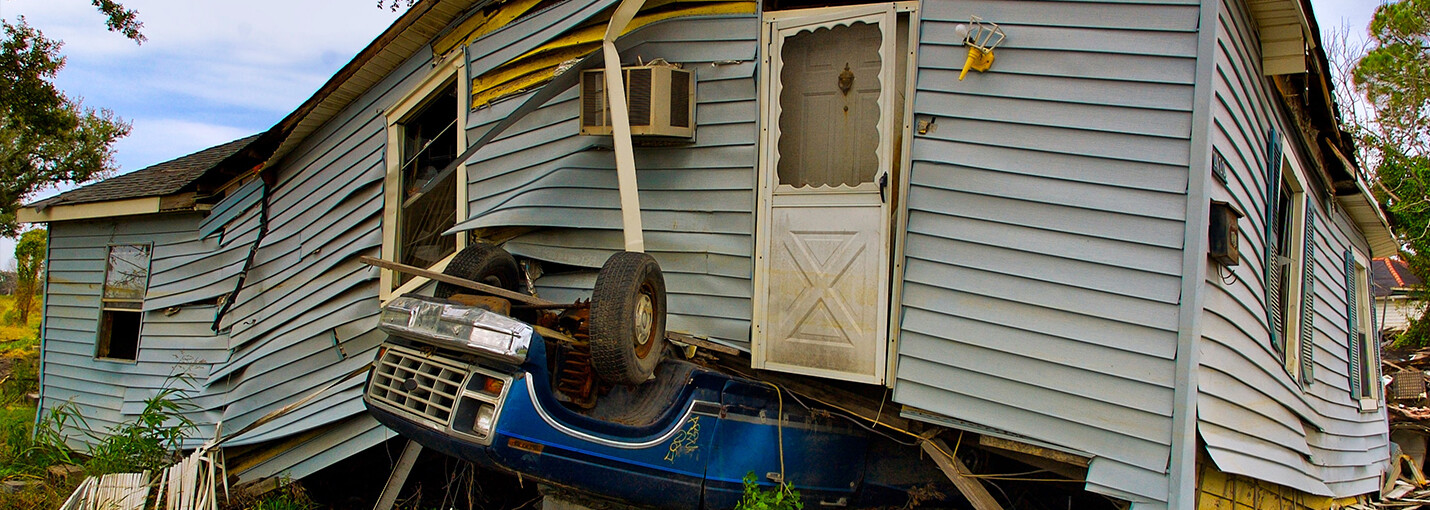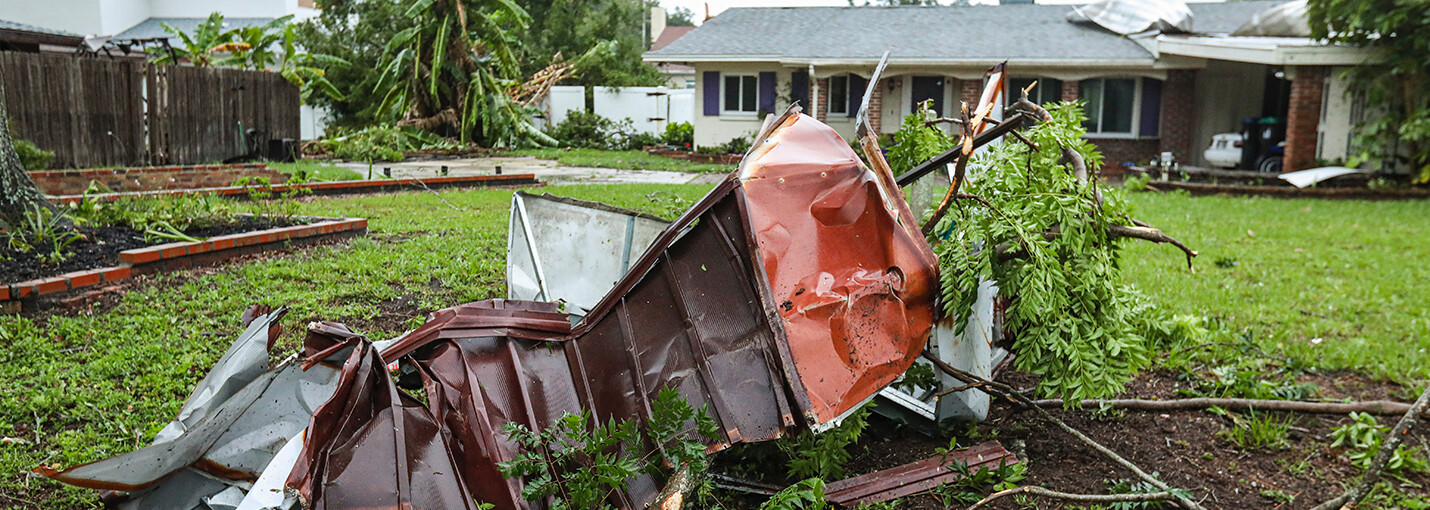Hurricane Debris: Asbestos Flooring and Carpets
With hurricane season just around the corner, it’s important to know the potential dangers of asbestos exposure. Hurricanes not only cause significant property damage, but, as a result, they can kick latent asbestos into the air, especially because the mineral was long used in construction. And while most people know the risks of asbestos lingering in roofing, wall insulation, and ceiling titles, it can also lurk in different types of flooring, including carpet.
!
If you may have been exposed to asbestos, speak with your healthcare provider about tests and screening to help detect the presence of asbestos fibers and asbestos-related diseases.

Another danger from hurricanes: asbestos debris
Asbestos is a naturally occurring mineral that was widely used up until the mid-1980s. It was commonly applied to flooring materials, such as in tiles and carpeting, and as well as in insulation beneath floorboards. If these materials are damaged during a hurricane, or while renovating an older home, fibers can become airborne and pose a serious health risk.
One of the most significant risks associated with asbestos-containing flooring is that it’s relatively easy for microscopic fibers to become disturbed, either through renovation or demolition. This is especially true in the wake of a hurricane, of course, when the debris is scattered every which way, and cleanup efforts commence in the aftermath.
Even embedded asbestos fibers can become airborne if a product is torn, damaged and tossed around… as unfortunately hurricanes often do.
While some types of asbestos-containing tiling and carpeting may be less dangerous than others (such as those that are well-maintained and not damaged), even these can become hazardous when the integrity of the material is compromised. Thus, as a homeowner in New Orleans, or the surrounding areas, understanding the exposure risks associated with hurricane season is important. If one plans to refurbish or demolish an older home, or if they plan to remove post-hurricane rubble, taking precautions while doing so is vital.
The prominence of historic buildings in New Orleans means there is more residual asbestos.
In New Orleans, specifically, there are many historic buildings – both commercial and residential – and there is a high likelihood of asbestos-containing materials being present. Here are some precautionary measures that should be followed when working around asbestos-containing flooring:
Safety Tips for avoiding and dealing with asbestos hurricane debris
Get a professional inspection: Securing a professional inspection before starting any renovation or demolition work is key. An asbestos inspector can test the materials and determine whether they contain the mineral. If asbestos is present, an abatement team can then be called in to safely remove it.
Don’t disturb asbestos-containing materials: If any type of flooring is found to contain asbestos, it’s important to avoid disturbing it. Fibers can become airborne when materials are broken up or tossed around. If it’s necessary to handle asbestos in any way, one should always wear protective gear.
Use caution when removing old flooring/carpeting: Flooring that is scheduled to be removed, especially if installed prior to the ‘80s, likely contains asbestos. Thus, it’s important to use caution and take appropriate safety measures when completing the job. Again, it’s best to hire a professional asbestos abatement team to do the work.
Be aware of the ongoing danger: Even if older materials have been completely removed, there is still a risk of exposure amid remaining debris and surfaces that may have been contaminated during a project (or a hurricane). Having an area retested after a remodel or demo is the best way to ensure all lingering asbestos is eliminated.
Consider safer alternatives: When installing new flooring, there are now many eco-friendly and non-toxic options to consider that do not contain asbestos.
Again, the biggest key to staying safe is to work with someone who is professionally trained in handling asbestos-containing materials. A professional will be able to test any suspect flooring and safely remove asbestos without exposing anyone to harmful fibers.

Second-hand asbestos exposure (Secondary Asbestos Exposure)
Even the workers’ families were affected due to secondhand exposure—asbestos fibers are extremely durable and can cling to skin and clothing, traveling great distances with those directly exposed.
Asbestos fibers have no taste or smell, and can be microscopic, so you may not realize you were breathing them.
Unfortunately, many workers’ families and other household members were exposed to asbestos as well, as asbestos was brought home daily in neighborhoods across the U.S. on work-clothing.
This is often known as secondary or second-hand asbestos exposure (or domestic / household family asbestos exposure). In studies of asbestos disease, 1 in 5 cases of asbestos exposure were caused by secondary asbestos exposure.1
But spouses and children can also receive a share of the $30 Billion in asbestos trust compensation if they were exposed to asbestos brought into the house or family vehicle by a worker.
Do You Qualify For Compensation?
Quickly and easily find out how you were exposed by searching W.A.R.D., the largest asbestos database on the planet.
FREE SEARCH >Asbestos testing and abatement should ideally be conducted by an experienced and licensed professional.
Should asbestos be present, removing it should never be a DIY job. Attempting to do so will only increase the risk of exposure, and improper disposal of asbestos-containing materials can mean legal trouble. While it can be costly to remove asbestos the right way, cutting corners could lead to unexpected costs down the line.
If planning to work near (or in) an older home, especially in the aftermath of a hurricane, wearing protective clothing and a respirator to avoid inhaling airborne fibers is also key. Assuming that debris contains toxins is the best way to ensure the necessary precautions are taken.
Asbestos may not be a primary concern during a hurricane. But it should be considered, especially when dealing with clean up.
Nonfriable asbestos generally will not pose a hazard to one’s health. However, hurricanes cause massive destruction and tend to stir up latent fibers, causing them to become friable and be inhaled. Thus, more often than not, even areas that were deemed low risk become high risk after a natural disaster.
Seeking medical attention and getting re-checked regularly should a person suspect they’ve been exposed will ensure their health is maintained, or at the very least, an early diagnosis and treatment is made possible.
Asbestos exposure can lead to serious health problems, including lung cancer, mesothelioma, and asbestosis. If diagnosed with an asbestos-related illness, contacting a law firm that specializes in asbestos claims can help a client navigate the often-complicated legal process and mean securing the compensation necessary to pay for medical bills and improve one’s quality of life.
Need some answers?Call us. No commiment, the info is free. |
AsbestosClaims.Law
For Justinian C. Lane, getting compensation for asbestos victims is personal.
Justinian’s grandparents and his father all worked with asbestos in their younger years and died from asbestos-related cancers in their later years.
At the time of each of their deaths, no one in Justinian’s family knew that they were eligible to file an asbestos lawsuit and to seek compensation from the asbestos trusts.
Because no one in Justinian’s family knew their options, they never received any compensation for the death of their loved ones.
If you believe that you or your family member’s injury was related to asbestos exposure, you could be entitled to significant compensation.
This is money you could use to cover the costs of asbestos removal services, pay for medical treatment, and preemptively protect your physical well-being.
There are also asbestos trusts that offer compensation much more quickly and easily (without filing a lawsuit.)
If you’d like help with filing a claim, please get in touch by email at [email protected], or call or text us at (833) 4-ASBESTOS (427-2378) or (206) 455-9190. We’ll listen to your story and explain your options. And we never charge for anything unless you receive money in your pocket.
In addition to legal claims, veterans disability, social security and employment protection like workers compensation, FELA and The Jones Act for maritime workers, there are asbestos trusts that have been set up to compensate those harmed by asbestos without having to file a lawsuit.
There is no risk or cost to speak with one of our staff about your asbestos litigation. There are no fees unless you receive money.
If you have any additional questions or concerns related to asbestos, check out our website and YouTube page for videos, infographics and answers to your questions about asbestos, including health and safety, asbestos testing, removing asbestos from your home and building, and legal information about compensation for asbestos injuries.
Introducing the largest database of asbestos information on the planet.
W.A.R.D., which stands for the Worldwide Asbestos Research Database, helps clients to narrow down when and where they may have been exposed, as well as which products may still contain asbestos. W.A.R.D. will also help indicate compensation types and how much a person may be entitled to.
1. Tompa E, Kalcevich C, McLeod C, Lebeau M, Song C, McLeod K, et al. The economic burden of lung cancer and mesothelioma due to occupational and para-occupational asbestos exposure. Occup Environ Med 2017; 74: 816-22.